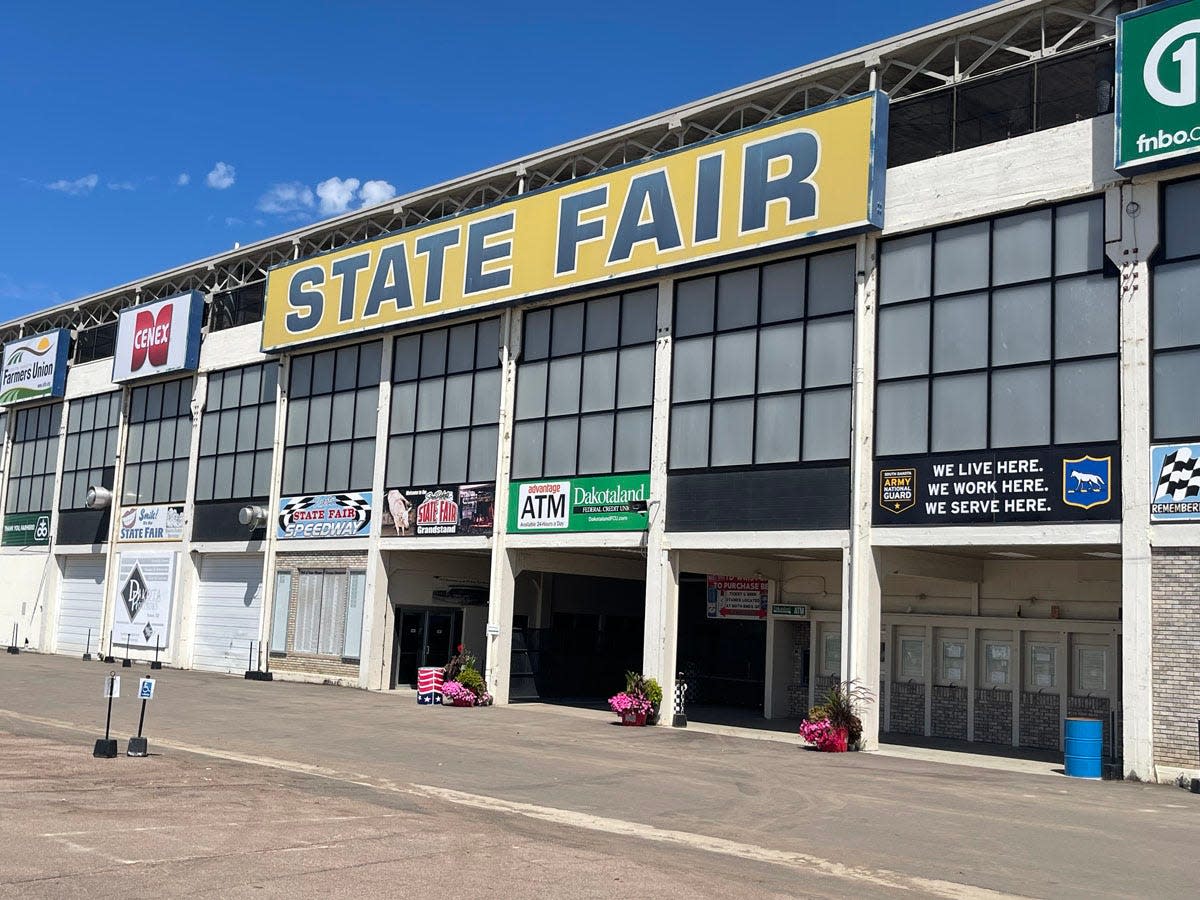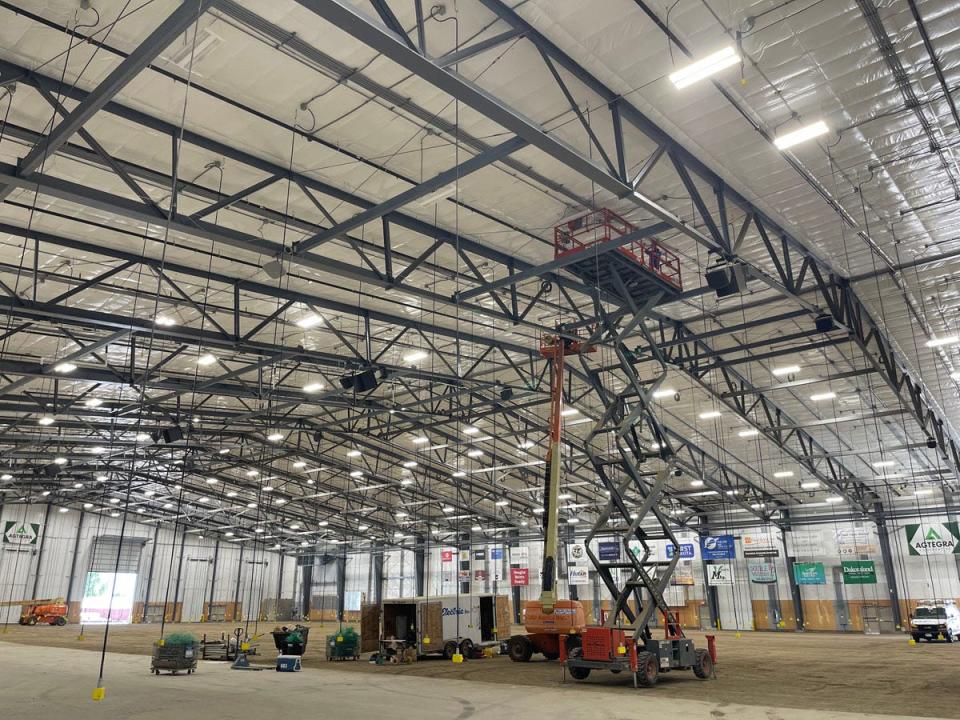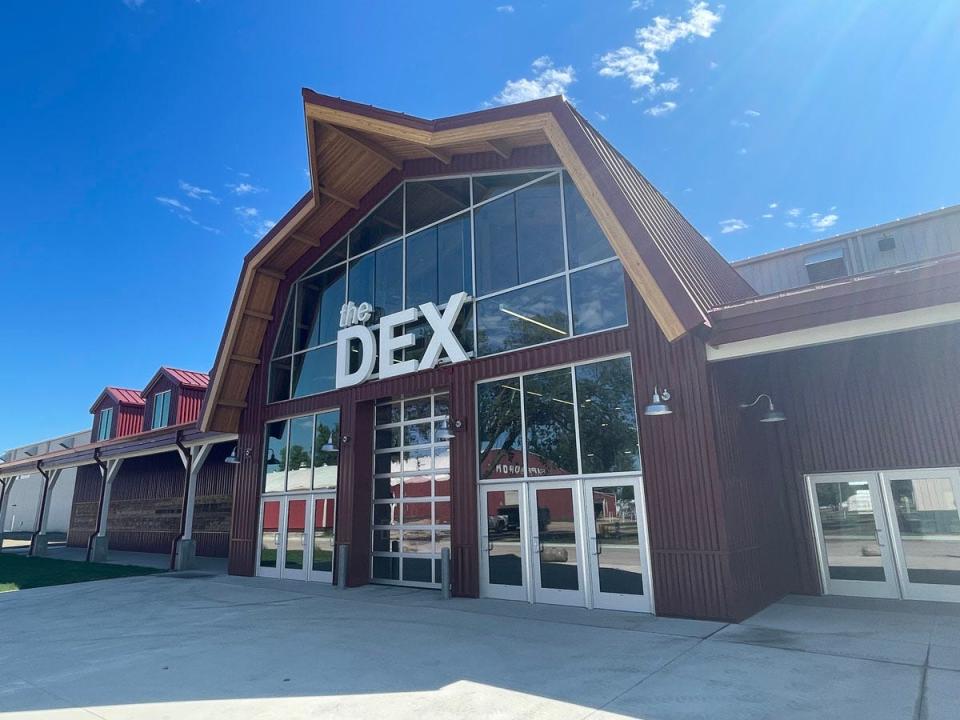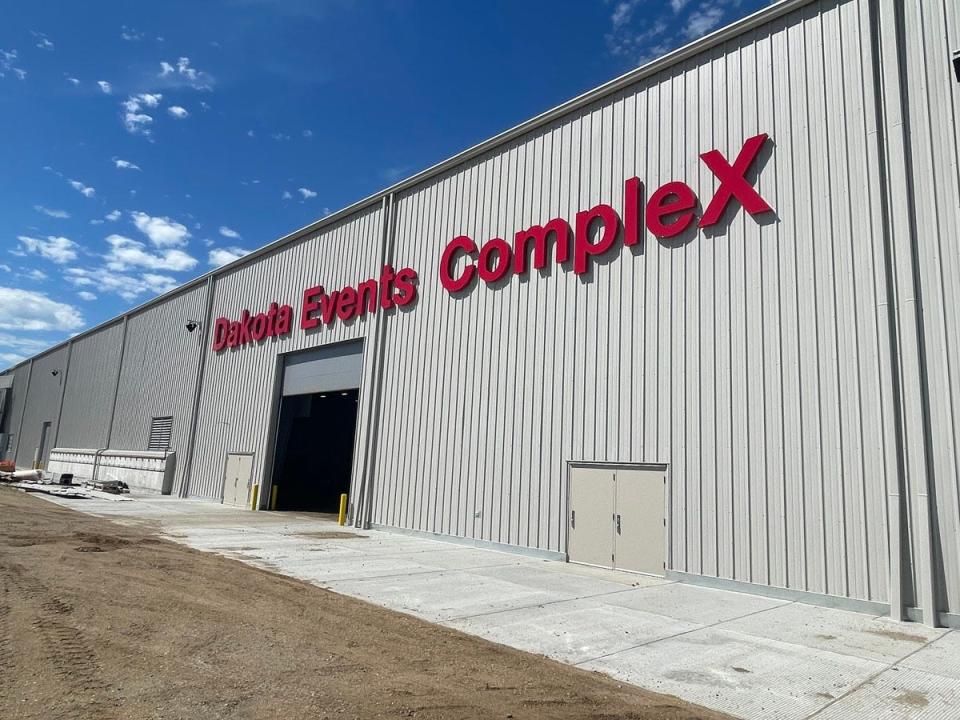$29 million South Dakota State Fair building behind schedule

- Oops!Something went wrong.Please try again later.
HURON, S.D. – In her December 2020 budget address, Gov. Kristi Noem laid out a plan for a state-of-the-art events facility at the South Dakota State Fair to replace the old livestock complex, which had been destroyed by fire about a month earlier.
The governor’s proposal sought to double the size of the former facility with a heated building for 4-H and Future Farmers of America events to be unveiled in 2022. Noem also spoke of luring national rodeo and equestrian competitions to spark revenue for the state fair and the community.
“Our goal is to become the No. 1 choice for equestrian and livestock events in the country and for attracting new opportunities to South Dakota,” Noem told legislators during her 2020 address. “I look forward to seeing you all in the new livestock complex at the 2022 State Fair.”
More than 2-½ years later, with the 2023 State Fair beginning Aug. 31, pandemic-related construction delays and cost overrides have hampered the governor’s vision. The Dakota Events Complex, known as the DEX, was not ready to open in 2022, and its bleachers won’t be available for this year’s fair, dampening some of the enthusiasm for its unveiling.

The grand opening slated for opening day is now described as a ribbon-cutting ceremony, with beef exhibits and shows still scheduled at the facility during the fair. The official grand opening celebration is planned for 2024 as part of the Governor’s Agricultural Summit.
“The concrete is poured and the building is there. But until we get the bleachers, the project is not complete to the point where people can see what it’s all about,” said Jim White, a longtime Huron resident and former state legislator who led the DEX fundraising effort. “It’s a work in progress, needless to say.”
White gave a tour of the sprawling 150,000 square foot complex as crews on scissor lifts did electrical work near the roof. The barn-themed modern entrance on the west side features large signage, wood-beamed ceilings, restrooms and a concessions area. On the east side of the building, crews were still working to complete watering stations for livestock.
Construction delays coincided with the state fair raising ticket prices for the first time since 2015. Daily admission increased from $6 to $10 for adults, with weekly passes up to $40 from the previous $25. For youth ages 6-15, tickets are $5 a day and $20 for the 2023 fair, which runs Aug. 31-Sept. 4. Advance tickets are sold at a discounted rate.
Legislators have so far appropriated $29 million for the Dakota Events Complex, which can hold two full-size equestrian arenas or 1,700-plus cattle stalls. Those appropriations include $18 million in general funds, $6 million in private fundraising and much of the rest from insurance payments from the loss of the old facility.

The first round of funding, $20 million, was approved in 2021, and a second round of $9 million was rubber-stamped in 2023 after costs started to escalate. The facility has been scaled back from 200,000 square feet to 150,000 and from a seating capacity of 7,000 to 5,000 due to concerns about the overall price tag.
Noem’s office and the Department of Agriculture and Natural Resources (DANR), which oversees the financial management of the state fair, attributed budget overruns and construction delays to the COVID-19 pandemic and backorders on steel.
But the funding and outlook of DEX has drawn the scrutiny of lawmakers, reviving a decades-old debate over whether the state fair should stand on its own financially or be subsidized by taxpayers.
State Sen. Jean Hunhoff, a Yankton Republican and co-chair of the Joint Appropriations Committee, has criticized the lack of a business plan to show how the DEX will bring in enough revenue to make up for increased expenditures needed to manage and market the complex.
The state fair fund had a negative cash flow of $1.5 million in fiscal year 2022, dropping its balance from $2.8 million to $1.3 million, according to the Office of the State Treasurer. The fair received a transfer of $721,582 from state general funds in 2021 due to pandemic-related revenue losses, based on Noem’s recommendation.
“Are they ever going to be totally self-sufficient? I don’t think so,” said Hunhoff.
“But they’re also not at the level that we expect them to be. South Dakota is an ag state, so you want a nice facility, but you need to be able to market it. They’re indicating to us, ‘If you build it, they will come.’ Well, you need to have programming that prompts people to come there, especially if you want (the Legislature) to continue to contribute.”
Attendance at the five-day fair was 192,279 in 2022, the highest since the pandemic but lower than every year between 2014 and 2019.
The Noem administration denied News Watch requests to interview Agriculture and Natural Resources Secretary Hunter Roberts and State Fair Manager Peggy Besch.
Besch presented a plan to lawmakers in June 2022 to raise ticket prices and camping fees for the 2022 state fair. She noted that the proposed prices were less than rates charged at state fairs in Minnesota, Wisconsin, Iowa, Colorado and North Dakota.
The fee increases were projected to generate $280,000 annually, Besch told the Legislature’s Rules Review Committee, which would be used in part to hire staff to manage and promote the DEX. She acknowledged at the time she didn’t have a specific business plan to reflect those needs or expenses.
The process faltered when Hunhoff chastised Besch and the State Fair Commission for not mentioning the fee increases at a DANR budget hearing that took place during session, instead trying to push it through the five-member committee panel.
The fee changes were not allowed to go into effect.
“I was very verbal about them bypassing appropriations,” said Hunhoff. “I said, ‘Had you told us you were going to do that by putting it in your budget, we would have been more receptive, but you really didn’t follow the process.’ So those rules got reverted back (by a vote of 4-1).”

During the 2023 legislative session, the fee increases were part of the DANR’s budget outline, along with the additional $9 million in appropriations to complete construction of the DEX.
Both requests passed as part of the budgetary process.
Roberts and Besch faced questions about their premise that the events center will spark increased revenue by luring national events to Huron on a year-round basis.
“Most of the activities they’ve hosted in the past have been spring and summer, and now they have to look at utilizing that complex all year round,” said Hunhoff. “We’re taking them to task by saying, ‘We’re being supportive in helping you to finance this building and create this state-of-the-art complex, but what are you doing to market it?’ We want to see some metrics come out of that.”
This article was produced by South Dakota News Watch, a non-profit journalism organization located online at sdnewswatch.org.
This article originally appeared on Sioux Falls Argus Leader: $29 million South Dakota State Fair building behind schedule


